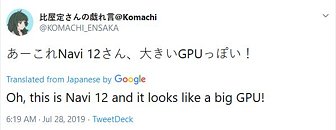Monday, July 29th 2019

AMD Readies Larger 7nm "Navi 12" Silicon to Power Radeon RX 5800 Series?
AMD is developing a larger GPU based on its new "Navi" architecture to power a new high-end graphics card family, likely the Radeon RX 5800 series. The codename "Navi 12" is doing rounds on social media through familiar accounts that have high credibility with pre-launch news and rumors. The "Navi 10" silicon was designed to compete with NVIDIA's "TU106," as its "XT" and "Pro" variants outperform NVIDIA's original RTX 2060 and RTX 2070, forcing it to develop the RTX 20 Super series, by moving up specifications a notch.
Refreshing its $500 price-point was particularly costly for NVIDIA, as it was forced to tap into the 13.6 billion-transistor "TU104" silicon to carve out the RTX 2070 Super; while for the RTX 2060 Super, it had to spend 33 percent more on the memory chips. With the "Navi 12" silicon, AMD is probably looking to take a swing at NVIDIA's "TU104" silicon, which has been maxed out by the RTX 2080 Super, disrupting the company's $500-700 lineup once again, with its XT and Pro variants. There's also a remote possibility of "Navi 12" being an even bigger chip, targeting the "TU102."
Source:
KOMACHI_ENSAKA (Twitter)
Refreshing its $500 price-point was particularly costly for NVIDIA, as it was forced to tap into the 13.6 billion-transistor "TU104" silicon to carve out the RTX 2070 Super; while for the RTX 2060 Super, it had to spend 33 percent more on the memory chips. With the "Navi 12" silicon, AMD is probably looking to take a swing at NVIDIA's "TU104" silicon, which has been maxed out by the RTX 2080 Super, disrupting the company's $500-700 lineup once again, with its XT and Pro variants. There's also a remote possibility of "Navi 12" being an even bigger chip, targeting the "TU102."

132 Comments on AMD Readies Larger 7nm "Navi 12" Silicon to Power Radeon RX 5800 Series?
That is why I'm more interested in actual performance than a bump in specs. History has a tendency to repeat. On paper the 2080ti and a potential Navi upgrade may seem equal, but we're still looking at a node difference to make it happen. Last time AMD used HBM to cover the gap (unsuccessfully) and now its 7nm; this will catch up on them fast.
Since when do you care for a 50w tdp difference when there is (maybe??) performance to back that up?
Let's all just buy 1030's then
Polaris 11, 12, and 21 were smaller dies, cut-down from 2304SP of the full Polaris chip to 1024 and 640SP
I don't think Navi 12 will be a larger chip - The halo market is vanishingly small and expensive to operate in. AMD are far more likely to be chasing the mass-market where 90% of sales are with a lower-TDP, cheaper-to-make chip that serves the $200 and lower market, as well as being laptop-friendly. I'm only guessing, but I think that *if* AMD make a larger Navi die, it'll be called Navi 20, or given an new codename altogether.
Those 20% more shaders and a less crappy cooler could put it right into 2080 territory IF Navi scales well.
Not that I believe a large Navi would use something like this, AMD would definitely go for 12 GB on 384 bit for the extra bandwidth.
if it turns out able to compete 2080 Ti Super Mega Beyond Your Imagination Huang Edition in terms of price/performance why not?
/funny
Problem is, we don't know if Navi is actually scalable like that. Navi 12 might just be 48 CU/8 GiB which would target TU104.
And when it comes to power consumption, the main concern for heat, noise, throttling etc. is average consumption, not peak consumption.
RX 5700 XT already consumes ~225W for 40 CUs/2560 SPs, that's going to increase a lot if AMD wants larger dies, or they have to sacrifice a lot of clock speed.
RX 480 = Polaris 10
RX 580 = Polaris 20
RX 590 = Polaris 30
Vega 64 = Vega 10
Radeon VII = Vega 20
Here's a more realistic take on market shares over time
gpu.userbenchmark.com/Nvidia-RTX-2080-Ti/Rating/4027